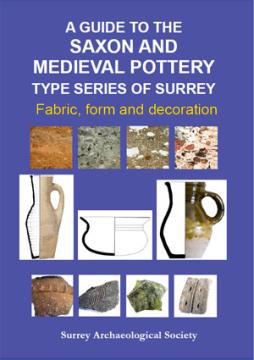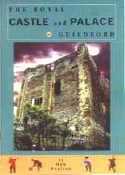Publications
A full list of the Society's publications may be obtained from the Abinger Library and Research Centre or see the separate publications list (27k) on this web site. Please note the Research Centre is only currently able to accept cash or cheques (please make cheques payable to Surrey Archaeological Society)
A Guide to Roman Pottery from Selected Sites in Surrey

This updated quick guide to Roman pottery in Surrey uses the Museum of London Fabric Codes and helps to identify pottery sherds found during fieldwalking, on excavations or in your garden. The Guide has a clear description of the pottery fabric and the typical forms for each fabric. Images at high magnification show the fabric of the many types of pottery found in Surrey and provide dating details for the different fabrics. Other images show decoration techniques frequently used on the surface of Roman pottery. The Guide should be used in conjunction with the physical type series held at the Abinger Research Centre (please contact the Library for more information).
Size A5 with a laminated cover, 53 pages with 80 photographs and 5 tables and illustrations.
Price: £2.00 for p+p
A Guide to Saxon and Medieval Type Series of Surrey

This updated quick guide to Saxon and Medieval pottery in Surrey is based on Phil Jones’s Medieval pottery type series, developed over many years of studying Medieval pottery found in Surrey. The guide helps to identify pottery sherds found during fieldwalking, on excavations or in your garden. It has a clear description of the pottery fabric and the typical forms for each fabric. Images at high magnification show the fabric of the many types of Medieval pottery found in Surrey. Other images show typical sherds and the decoration and glazes frequently used on the surface of Medieval pottery.The Guide should be used in conjunction with the physical type series held at the Abinger Research Centre (please contact the Library for more information).
Size A5 with a laminated cover, 38 pages with 72 photographs and 8 tables and illustrations.
Price: £2.00 for p+p
A Guide to Post-Medieval Pottery in Surrey

This quick guide to post-Medieval pottery in Surrey uses the Museum of London Fabric Codes and helps to identify pottery sherds found during fieldwalking, on excavations or in your garden. The Guide has a clear description of the pottery fabric and the typical forms for each fabric. Images at high magnification show the fabric of the many types of pottery found in Surrey. Other images show typical sherds and the decoration and glazes frequently used on the surface of post-Medieval pottery.The Guide should be used in conjunction with the physical type series held at the Abinger Research Centre (please contact the Library for more information).
Size A5 with a laminated cover, 52 pages with 86 photographs and 6 tables and illustrations.
Price: £2.00 for p+p
The Development of Timber Framing in Surrey's Old Buildings by Rod Wild and Andy Moir with Martin Higgins and Brigid Fice

The Domestic Buildings Research Group (Surrey) joined forces with Surrey Archaeological Society to set up the Surrey Dendrochronology Project, with the support of Surrey County Council and a generous grant from the Heritage Lottery Fund.
The objective of the project was to map the development of timber-framed buildings, century by century, area by area, across the county, using tree-ring dating.
This fully illustrated report explains the findings of the Project, providing an accurate picture of how the vernacular architecture of Surrey has evolved.
A limited number of copies are available at £20. Copies can also be obtained by post for £20 + £5.00 (p&p) from https://www.dbrg.org.uk/surrey-dendrochronology-project
Folklore of Surrey by Matthew Alexander

Folklore of Surrey is framed around ‘Old Surrey’, the working-class traditions of village and market towns in the 19th century, although additional material takes the story down to living culture for popular themes such as ghosts and childlore. Some traditions rely on a single record, but several have multiple records over time and it is a strength of this book that it traces evolution and development in a subject which has often been treated as static. The growth of legends like Mother Ludlam’s Cave and popular customs like Christmas visiting is well handled.
All the folklore is referenced to primary sources and it is made clear when there has been feedback from literary inventions such as the Silent Pool and Blanche Heriot of Chertsey. The judgements on earlier collectors like Edward Lovett or Charles Kerry of Puttenham are illuminating. What might seem undifferentiated ‘tradition’ is teased out into the lore of specific micro-communities: crafts, age groups, competitive village communities.
For Surrey researchers, the book is rich in material that will feed into broader debates about local history, especially those occasions when tradition was made the flash-point for conflict, as in the Guildford Guy Riots. The imposition of Victorian civility on popular proletarian resistance is a running theme from areas such as street football to wife-swapping. Folklore was a force for both cohesion and exclusion as is made clear in such topics as legendary village origins and witchcraft.
Price £12.99 (£3.00 p+p) Copies are also available from Guildford Museum and Surrey History Centre and will be available from Bourne Hall Museum when the shop reopens.
Aspects of Archaeology and History in Surrey: towards a research framework for the county

This volume was published to coincide with the 150th anniversary of the Society. It gathers together a number of papers presented at a conference held in June 2001. Topics covered include:
The environmental history of Surrey; Engraved sequences and the perception of prehistoric country; Roman religious sites in the landscape; Supre-ge - the foundations of Surrey; The Surrey Historic Landscape Characterisation Project; Vernacular architecture; The impact of royal landholdings 1509-1649; Iron production in Surrey; Second World War defences in Surrey.
Size A4; xi + 260 pages including both colour and monochrome illustrations. Price: £25 (add £5.00 p&p)
Ewell: a Surrey Village that Became a Town

This, the third publication resulting from the Society's Villages Project, records the growth and development of Ewell in north-east Surrey. The information is presented through a series of maps from the medieval period through to the 19th century. This booklet is the result of research carried out by Charles Abdy assisted by members of Epsom & Ewell History & Archaeology Society.
Size A4; 47 pages including 19 maps. Price: £3.00 (add £2.00 p&p)
Thorpe: a Surrey Village in Maps

This, the second publication resulting from the Society's Villages Project, records the growth and development of the village of Thorpe in north-west Surrey. The information is presented through a series of maps from the medieval period through to the 19th century. This booklet is the result of research carried out by members of the Egham-by-Runnymede Historical Society.
Size A4; 54 pages including 25 maps of which 6 are in colour.
Price: £3.00 (add £2.00 p&p)
Gomshall , Peaslake and Ewhurst. Rural Villages from Royal Vill

On the growth in the Surrey Hills of the neighbouring settlements of Gomshall, Peaslake and Ewhurst, which were all part of the single maour of Gomeselle at the time of Domesday. Researched and prepared by members of Gomshall, Shere and Peaslake Local History Society and Ewhurst History Society.
Size A4; 71 pages including 15 maps of which 7 are in colour
Price: £5.00 (add £2.00 p&p)
The Royal Castle and Palace at Guildford by Rob Poulton

This popular booklet presents the results of a four-year training and research excavation by the Society, which was highly successful in rediscovering the site of the lost palace and the layout of many of its buildings. Full colour illustrations include photographs of the excavation, standing buildings, maps, plans and reconstruction drawings. The booklet offers useful resource material for local history studies and for Key Stage 3 study of medieval realms.
Size A4; 16 pages with many illustrations.
Price £1.50 (inc p&p)
Bulletin
The Bulletin has now been renamed Surreys Past which is issued free to members and is published three times a year. It provides news of current work and events and also notices of local society meetings within the county. The Bulletin Editor welcomes short articles on current work within the county, which should be sent to the Abinger Library and Research Centre.
